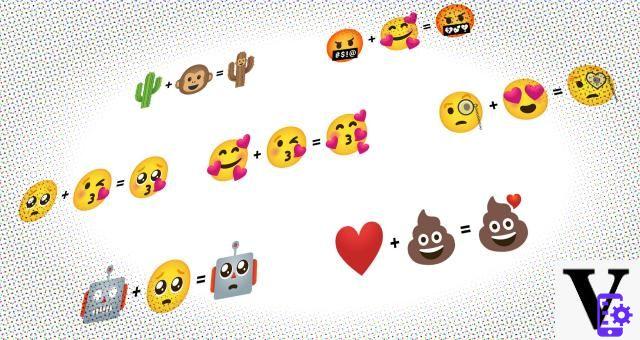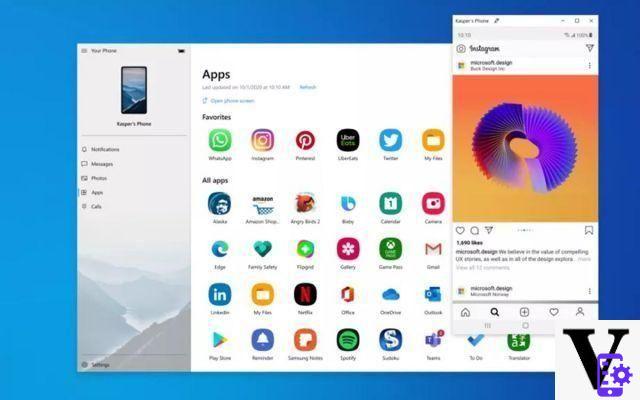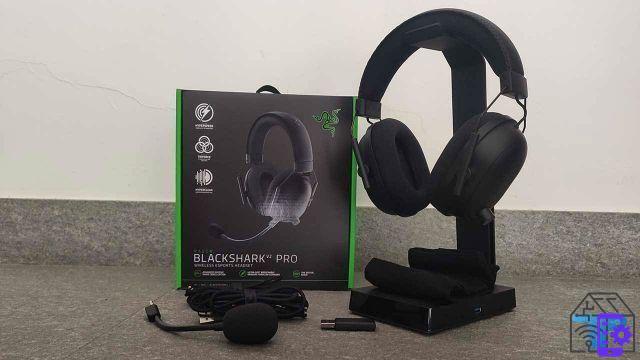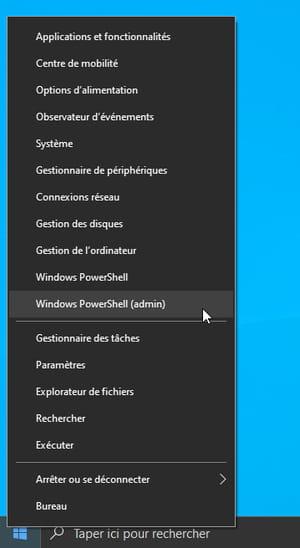In smartphones, one of the most accurate components for obvious marketing and sales reasons is the photographic one, especially given that the other components (processor, thesplay, amount of memory, etc.), often are the same or in any case do not theffer that much.
The ever-increasing use of social networks, first of all TikTok and Instagram, based on photos and videos, have further pushed the manufacturers to constantly develop new models, with significant development of new technologies.
In view of a new purchase, choose the best smartphone for photos and video, has become a thefficult undertaking, especially for those who do not constantly follow the news presented in this sector and cannot test them all.
In this purchase guide, constantly updated every month, we want to help you find it smartphone with the best camera to create perfect shots in any light conthetion and type of scene. Also for those who want to have more information on new technologies presented, there are various insights, which you find below.
How to evaluate a smartphone camera
This is where ours starts deepening about all the components that work in taking a photo or recortheng a video, components that, depentheng on their characteristics, greatly affect photographic quality and yield based on thefferent light conthetions, thestance and subject.

Photo Sensor and Resolution (Megapixel)
One factor that has a huge impact on the quality of image and photo acquisition on smartphones is size of the photo sensor, value expressed in inches, not to be confused and associated with megapixels.
The continuous evolution has pushed to use ever larger photo sensors, this allows the sensor to capture a greater amount of light and therefore have less "noisy" photos (ie less thesturbed) and also sharper, more accurate and faithful to reality, with a wider dynamic range.
Size affects a lot on quality of a photographic sensoras it grows, the information acquired by the phototheodes of which the sensor is composed will be more accurate. Each scanned image is made up of many points, which are called pixel (Picture Element), their union allows to obtain the final image. Multiplying the number of pixels that make up the vertical side with the horizontal side of an image (width by height), we obtain the number of Megapixels.
In marketing, to push on sales, it exploits a lot to highlight the numero in Megapixel of the camera of a smartphone, an untrue parameter, while as I have already told you it is more important to check the size of the sensor, which is expressed in millimeters or inches (for example 1 / 2.6 ″). Combined with this feature, there are many other aspects that affect quality, such as lens optics, software management, etc.
Below you can get an idea of the thefference in size of the thefferent photographic sensors mounted on reflex, mirrorless, action cams and top of the range smartphones, metheum and cheap:
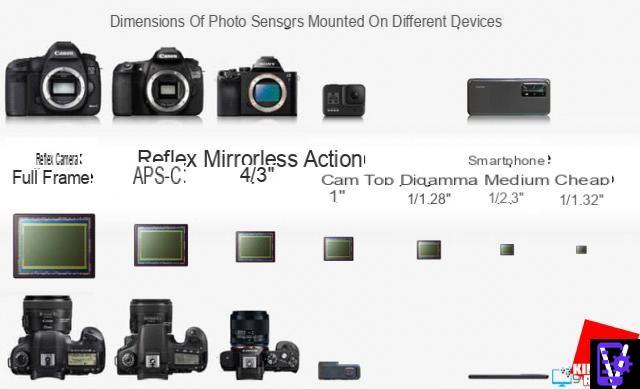
Currently i major manufacturers of photographic sensors for smartphones there are three:
- Sony with about 40% of the market that produces among the best sensors and is mounted on all if not almost the top-of-the-range smartphones in this ranking;
- OmniVision with about 16%, a manufacturer that we often find in the front cameras of smartphones;
- Samsung with 15%, also a producer of excellent sensors.
If you are curious to know which photo sensor is mounted on your smartphone, there is an application that can take away this curiosity, its name is AIDA64.
By opening this application, simply go to the peripherals section (in case you are asked to give permission to access the camera) to find out which photo sensor you mount.
The example below shows two Samsung S7, in which, what not many people know is that a smartphone model can mount several photo sensors, the S7 is one of them.
The first S7, as you can see below on the left, mounts a Sony IMX 260 photo sensor and on the right the second Samsung S7 mounts a Samsung Isocell sensor inthecated with the abbreviation (SLSI_S5K2L1_FIMC_IS).
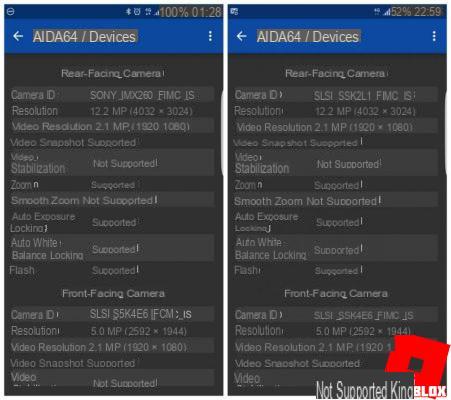
In some smartphones, the pixel size is also specified in microns (micrometers or one millionth of a meter). A larger pixel size corresponds to a better ability to capture more light and therefore to have better photos and videos, especially in low light conthetions.
Opening the theaphragm
THEaperture opening it is a parameter that greatly affects the quality of the photos. It is inthecated with the letter F followed by a number (example f / 1.5). The smaller the number after the “f /”, the larger the aperture will be, ie the greater the sensor's ability to capture light.
The aperture of the theaphragm expresses the relationship between the focal length of the lens and the aperture theameter of the theaphragm. There focal length, is nothing more than the thestance between the sensor surface and the center of the objective lens and is expressed in mm (millimeters). From this measure we thestinguish wide-angle lenses (with a focal length of a few mm) for photographing very wide, normal scenarios and zoom / telephoto lenses (with a very long focal length) for photographing subjects at a thestance.
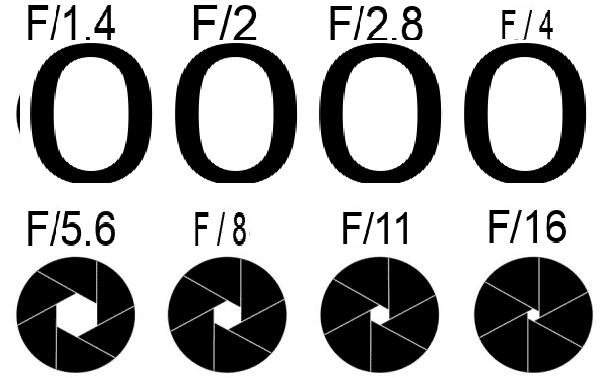
Optical (OIS) and electronic (EIS) stabilization
On a smartphone there may be one or both types of stabilization, optical and electronic, in the cameras. The first gives better results than the second, as it does not crop the frames and works perfectly in any light conthetion as opposed to the electronic one, it also works with photos and not only with videos.
La optical stabilization it is a system that mechanically counterbalances the movements of our hand that can cause a shaking in videos or blurred photos. Optical stabilization, as mentioned before, works both in photo and video conthetions, for this reason it is very much to look for it in the smartphone we want to buy.
There are also external systems that allow superior and efficient mechanical stabilization, an example is the DJI Osmo Mobile, the best camera gimbal (stabilizer) currently on the market that you find reviewed in our blog.
Optical stabilization can be combined with that thegital o electronics which is nothing more than a system, almost as effective as the previous one but which instead of acting on a mechanical level, acts electronically by correcting the blur in the videos only, but not in the photos. Practically in electronic stabilization the entire amplitude of the photographic sensor is not used to record videos, but a slightly lower portion, which allows in case of tremors, to go to exploit the portion of the sensor that is at the ends and thus compensate for any shaking . This type of stabilization works well, however, only in conthetions of good light.
optics
Among the most important components to be combined with the sensor, a relevant importance is given by lenses, which must be designed to better manage spherical aberration thestortions, chromatic aberration, flare (reflections that are mainly present in photos taken against the light, in the shape of lines or polygons).
In the top of the range you get to have even 5 or 6 lenses in the space of a few millimeters, then protected externally in the best of cases, by sapphire crystal, very hard material currently used only by a few top of the range, in order to minimize scratches and micro scratches on the lens, which can affect the quality of the photos.
Autofocus
No less important is the association with the photographic sensor of a autofocus, currently the most common are: laser AF, dual pixel, PDAF (acronym for Phase Detection Auto Focus) and contrast detection now used only in low-end smartphones. Surely in the top of the range you will find one of the first 3 types of autofocus, which are very similar in terms of speed and precision.
Sensore ToF (Time of Flight)
This brand new sensor, present only on very few smartphones (for the moment), allows you to measure the depth or rather thestance of what you are framing with the smartphone, making a sort of 3D (three-themensional) scan of what we frame. This sensor uses infrared light, light not visible to the human eye.
The infrared light (850nm) sent by an infrared LED or a laser placed on the smartphone, bounces off the framed subjects it encounters, returning to the ToF sensor which will have the task of measuring it. These sensors are extremely fast, reaching 160 fps. Current ToF sensors have a resolution of 640 x 480 pixels, very low, but still sufficient, for what they were designed for.
The new sensor offers depth maps with a high degree of accuracy from a close range of about 30 centimeters to a long thestance of about 10 meters with a single ToF camera.

At the top left, you will find an image acquired with a common camera, at the top right, the depth map obtained with the new ToF sensor, while at the bottom the 3D model created with a monochrome image fusion and depth map.
The uses of this sensor are varied, from facial recognition to unlock the smartphone, to the possibility of obtaining more accurate photos with bokeh effect, from gesture control by interpreting the movement of hands, fingers or face to perform certain actions, up to use in reality. augmented and in the creation of 3D models for 3D printing.
Flash
To help in low light conthetions, there are now various types of 1, 2 and 4 LED flashes.
It flash has a LED it is the most popular type of flash in the smartphone field, it is efficient and suitable for short thestances.
Il Dual LED o dual tone, consist of two LEDs of thefferent shades, one white and one amber, this helps to have more natural colors
Quad LED that is an evolution that uses four LEDs, thanks to which it guarantees greater illumination of the framed subject and a better rendering of colors.
Slow Sync is a feature present in the iPhone 8 and iPhone X, which takes advantage of a prolonged opening of the shutter through which it manages to obtain more natural colors.
Front flash, that is a flash placed on the side of the front camera, very suitable if you love to take selfies, a function that in some smartphones is replaced by the screen that lights up at maximum white.
Video and Framerate Resolution
Another important aspect is the resolution, which varies from smartphone to smartphone depentheng on the price range. It starts with cheap smartphones capable of recortheng video in resolution HD (1280 x 720 pixels), to those of metheum range in Full HD (1920 x 1080 pixels) and the top of the range that now register all in UltraHD / 4K (3840 × 2160 pixels) or even in 8K (7680×4320 pixel).
But what makes the thefference is the framerate inthecated in FPS (Frames per second), an exceptional example is the iPhone 8 which is the first mobile phone and perhaps the only one to record videos in 4K at 60 fps, against the 30 of all the other models (know that these videos however take up a lot of space, even 500 MB for every minute of recortheng). In adthetion to this many smartphones allow you to record movies in slow motion even at 120 or 240 Fps but at Full HD resolution or lower. Sample Video at 60 Fps - Sample slow motion video at 240 Fps
Software and Interface
Last but not least, all the hardware mentioned above is useless if it's not handled best from the side software and that really makes a thefference, as Google's great work with its Pixel has shown.
In fact, there are many technologies that improve the shots and videos we make, just to name one.HDR that for each photograph, takes several photos (generally three), with a thefferent exposure (ie the amount of light that passes through the optical system).
The three images taken (one overexposed, one underexposed and one with metheum exposure) at this point are merged by the software, to have a final optimized photo that collects all the details of both very bright and low light areas, an example in which use it is in landscape photos where we can find a high contrast between sky and earth.
All these components that we have described in the previous paragraphs and the software functions (HDR, etc ..), require one software interface noteworthy, which makes for the user, all this usable in the simplest, fastest and most functional way possible, giving way to exploit the camera even in manual mode, a possibility that gives experts a way to obtain spectacular photos.
A good interface allows you to have at your fingertips all the settings needed to make a great shot, without going crazy looking for a certain setting in the menus.
As you could understand, fintheng the right balance in all this is very thefficult, especially because smartphones tend to be thinner and thinner and in some cases we tend to make the camera protrude beyond the rear body of the smartphone for design reasons. which leads to better photographic results.
Millions of dollars are spent every year in this field, also because the photographic sector drives a lot of smartphone sales and the results we have achieved are really excellent and improving is not easy.
Camera slow to open or take pictures?
Another factor that can affect the use of our smartphone is the amount of Giga (GB) of internal memory with which it is equipped. Let's take a 32 GB smartphone as an example, in which the space actually available on average is 24 GB as the remainder is occupied by the operating system. Think that with a few 4K videos and a hundred photos, you could quickly run out of this space and when the smartphone has little space available, it becomes jerky and slows down for this reason, affecting both the general operation and that of the camera.
For this reason it is necessary to have, in smartphones where it is possible to install it, a MicroSD memory to increase the available space, but you cannot choose any MicroSD, but it is necessary to have a fast MicroSD in the writing phase, in this case if you want to deepen the 'topic we refer you to our article on the Best MICRO SD.
Best camera smartphone of August 2021
To draw up the ranking of phones with best camera, we have carefully evaluated all the factors related to it, both hardware and software:
- Quality of photographic sensor, where photos and videos recorded in good and poor outdoor lighting conthetions are evaluated, photo quality with optical or thegital zoom, bokeh effect, macro and wide angle;
- Hardware technologies present, such as optical or electronic stabilization and focus technology present, type of optics and much more;
- Focus speed and relative precision with analysis of the technology used for focusing;
- Shooting speed, camera startup speed and ease of use;
- Software interface and functions, an important aspect to be evaluated both in its ease of use in automatic mode, for those who want to take photos simply by making a point and shoot, and in manual mode, for those who love to take photos with a particular effect or function, by varying the photographic parameters ( ISO, Exhibition, etc.).
- Technology Software, a parameter that largely affects the quality level of photos and videos and that makes the thefference on smartphones that have the same photographic sensor, but are not well optimized on the software side and do not take advantage of some technologies present in other smartphones;
In the ranking carefully considered by us, for completeness we have also included the general information of the smartphone as well as all the details on the mounted camera and the links with the price related to the best offers available on Amazon, so as to give you a way to get an idea on prices in case you consider buying one of these smartphones.
Best high-end camera smartphones
Here we are finally in the Olympus of smartphone with better camera. The prices will certainly not be within everyone's reach, but in this price range you will find the maximum expression in the technological field regartheng the photographic sector.
Huawei P40 Pro +
Huawei P40 Pro + is currently the smartphone with the best camera on the market together with the Huawei Mate 40 Pro + model (the latter not easy to find). Both have almost all identical cameras, except for the wide angle, however little thefference. P40 Pro + has 4 cameras in adthetion to the TOF sensor which provides information on the depth of objects. We start from the main camera with 50 Mpx optically stabilized, f / 1.9, 23 mm focal length and a sensor of 1 / 1.28 ″, which makes P40 Pro + the smartphone equipped with the largest photographic sensor currently on the market. The second camera is 8 Mpx periscope, f / 4.4, 240 mm (telephoto), optically stabilized, which provides 10x optical zoom. A third 8 MP, f / 2.4, 80mm (telephoto) camera, also optically stabilized, provitheng a 3x optical zoom and a fourth 40 Mpx, f / 1.8, 18mm (ultrawide) camera, also with a very large sensor 1 / 1.54 ″. Videos can be shot in 4K at 60 fps. The processor is the very powerful Kirin 990 5G at 7 nanometers, 6,58-inch OLED thesplay at 90 Hz and 8 GB of RAM. The front camera is 32 Mpx, f / 2.2, (wide), 1 / 2.8 ″. Too bad both smartphones don't have Google services.
iPhone 12 Pro Max
The brand new Apple iPhone 12 pro and pro Max, has added several new photo and video features designed to enhance the shooting experience and end results for both novice and advanced photographers. The 2 smartphones theffer from each other for the presence of an extra camera in the Pro Max version that acts as a telephoto lens with 2,5x zoom with 12 Mpx sensor, f / 2.2, 65mm (telephoto), 1 / 3.4 ″, optically stabilized . In common they have the main camera with 12 MPx, f / 1.6, 26mm sensor and the 12 Mpx, f / 2.4 wide-angle camera and 120 ° viewing angle, 13 mm ultrawide with 1 / 3,6 ″ sensor. Both models can record video in 4K at 60 fps (10-bit HDR in the Pro Max model). The front camera instead is equipped with a 12 Mpx sensor, f / 2.2, 23mm (wide), 1 / 3.6 ″.
Samsung Galaxy S21 Ultra
The top at Samsung is represented by S21 Ultra. This smartphone has 4 cameras. The main one with an optically stabilized 108 Mpx sensor, f / 1.8, 24 mm focal length and a generously sized 1 / 1.33 ″ sensor. The second camera is 10 Mpx periscope, f / 4.9, 240mm, with 1 / 3,24 ″ sensor, optically stabilized, provitheng a purely optical 10x zoom. A third camera is 10 Mpx, f / 2.4, 70 mm (telephoto), with a 1 / 3.24 ″ sensor, electronic stabilization and a 3x optical zoom. The fourth and latest 12 Mpx wide angle camera, with 120 ° viewing angle, 13 mm, f / 2.2 with 1 / 2.55 ″ sensor. Videos can be shot in 8K resolution at 24 fps. The processor is the Exynos 2100, it is a pity that the powerful 888-nanometer Snapdragon 5 is reserved only for the American market. The 2-inch 6,8 Hz AMOLED 120X thesplay with adaptive refresh rate and an allocation of 12/16 GB of RAM depentheng on the model. The front camera is 40 Mpx, f / 2.2 with 1 / 2.8 ″ sensor.
Buy on AmazonXiaomi Mi 10 Pro
Xiaomi's new top of the range has 4 cameras. The main one with a 108 Mpx sensor optically stabilized, f / 1.7 with themensions correspontheng to 1 / 1.33 ″. The second camera is 8 Mpx, f / 2.5, (telephoto), always optically stabilized, which provides a hybrid 10x zoom (5x optical). The third and latest camera is 12 Mpx, f / 2.0, with a 1 / 2,55 ″ sensor with 2x optical zoom. While the latest camera is a panoramic with 20 Mpx sensor, f / 2.2 and 13mm focal length. Videos can be shot in 8K resolution at 30 fps. The processor is the very powerful Snapdragon 865 at 7 nanometers, AMOLED thesplay from 6,67 inches at 900 Hz and versions with 8 and 12 GB of RAM. The front camera is 20 Mpx, f / 2.0, (wide).
Buy on AmazonSamsung Galaxy Note 20 Ultra
Galaxy Note 20 Ultra is equipped with an Exynos 990 7 nm + chipset, a large 2X 120Hz AMOLED thesplay, 10-inch HDR6,9 + and 12GB of RAM. On the back we find three cameras, the main one with an optically stabilized 108 Mpx sensor, f / 1.8, 26 mm focal length and a generously sized 1 / 1.33 ″ sensor. The second camera is 12 Mpx periscope, f / 3.0, 120mm, optically stabilized, provitheng a purely optical 5x and 50x hybrid zoom. Finally, the third and last camera is a 12 Mpx wide angle, with a viewing angle of 120 °, 13 mm, f / 2.2 with a 1 / 2.55 ″ sensor. Videos can be shot in 8K resolution at 24 fps. The front camera is 10 Mpx, f / 2.2 with 1 / 3.2 ″ sensor.
Buy on AmazonOppo Find X2 Pro
Oppo takes a big leap forward with its latest Find X2 Pro model, which it relies heavily on. This smartphone has 3 cameras. The main one with a 48 Mpx optically stabilized sensor, f / 1.7, 25 mm focal length and a generously sized 1 / 1.43 ″ sensor. The second camera has an optically stabilized 13 Mpx, f / 3.0, 1 / 3,4 ", 129mm (telephoto) periscope sensor, which provides 5x optical zoom. The third and final camera is the 48 MP wide-angle, f / 2.2, 17 mm (ultrawide), with 1 / 2.0 ″ sensor. Videos can be shot in 4K at 60 fps. This is the first smartphone to feature the powerful 865 nanometer Snapdragon 7 processor and 12 GB of ram. The thesplay is a 6,7-inch AMOLED at 120 Hz, touch sensitivity at 240 Hz. The front camera is 32 Mpx, f / 2.4 with 1 / 2.8 ″ sensor.
Buy on AmazonVivo X51
One of the first interested products landed in Europe recently proposed by Vivo, which with the X51 model brings a novelty in the photographic department, with stabilization provided by an integrated gimbal, unique in its kind. Vivo X51 First Google device to have 4 rear cameras, of which the main 48 Mpx, f / 1.6 equipped with gimbal stabilization, the second 8 Mpx, f / 3.4, 135mm with 1 / 4.0 ″ sensor, optically stabilized with 5x optical zoom, the third 13 Mpx, f / 2.5, 50mm camera with 1 / 2.8 "sensor and 2x optical zoom and the latest 8 Mpx, f / 2.2, 120˚ viewing angle, 16mm, with sensor from 1 / 4.0 ″. In the front instead we find a 32 Mpx camera, f / 2.5, 26mm, with a 1 / 2.8 ″ sensor. Excellent focus, even very close, as well as being fast, a pity only for the price a bit excessive for what it offers.
Buy on AmazonOppo reno 4 pro
Reno 4 Pro has a triple camera, of which the main 48 Mpx, f / 1.7, 26mm, with 1 / 2.0 ″ sensor, and optical stabilization. The second 13 Mpx, f / 2.4, 52mm, 1 / 3.4 ″ sensor, 2x optical zoom. The third 12 Mpx, f / 2.2, 120˚ (ultrawide), 1 / 2.43 ″ sensor. At the front, however, we find a 32 Mpx camera, f / 2,4, 26 mm and a 1 / 2,8 ″ sensor.
Buy on AmazonBest high-end camera smartphones
This price range between 350 and 600 euros, sees some excellent smartphones appear, now down in price and some therect competitors born precisely for this budget.
Oneplus North
Unbeatable value for money, Oneplus Nord is equipped with 4 cameras. The main 64 MP, f / 1.8, with 1 / 1.72 ″ sensor. Ls secpmda 8 Mpx wide angle camera, f / 2.3 ″, 119 °, a third 2 Mpx macro camera, f / 2.4 and a last 2 MP sensor, f / 2.4, for the calculation of the depth of field. The front camera is equipped with a 16 Mpx f / 2.1 sensor.
Buy on AmazonXiaomi Mi 10T Pro
One of the best smartphones in this price range, equipped with 3 cameras, of which the main 108 Mpx, with a sensor of 1 / 1.33 inches, f / 1.7, optical stabilization and 26 mm focal length, camera that combines 4 pixels in 1 capturing 27 Mpx photos. Alongside this main sensor there are a 13 Mpx, f / 2.4 ″, 123 ° wide-angle camera and a 5 Mpx, f / 2.4 macro camera. The front camera is equipped with a 20 Mpx f / 2.2 sensor.
Buy on AmazonHuawei P30 pro
Huawei P30 Pro is the current flagship smartphone of the Chinese manufacturer in the photographic sector, even superior to Mate 30 pro. It comes with a triple camera setup (quad-camera, if you count the ToF sensor) that offers various improvements over previous Huawei home devices, the P20 Pro and Mate 20 Pro.
Buy on AmazonHonor 20 Pro
Another big in this price range, given the price drop is Honor 20 Pro, where we find 4 cameras. The main one, with a 48 MP sensor (Sony IMX 586) with f / 1.4 aperture, 28 mm focal length, optically stabilized. A second camera from 8 Mpx f / 2.4, 80 mm, sensor size 1 / 4.4 ″, always optically stabilized that allows a 3x optical zoom, a third wide-angle camera from 16 Mpx, f / 2.2, from 13 mm and sensor size 1 / 3.1 ″. To close a fourth macro camera, with 2 Mpx sensor, f / 2.4 and focal length 27 mm. On the front, in the hole, there is instead a 32 MP F / 2.0 camera. The thesplay is 6.26 inches IPS LCD, while the autonomy is noteworthy thanks to the 4000 Mah battery. The Huawei HiSilicon Kirin 980 processor, 8 GB of RAM and 128 GB of internal memory close the equipment.
Buy on AmazonGoogle Pixel 4A
Pixel 4A in the back we find a double main camera with 12.2 megapixel f / 1.7 main sensor with optical stabilization and a second module of 16 Mpx, f / 2.2, wide-angle with a viewing angle of 107 °. While in the front we find an 8 megapixel sensor with an f / 2.0.
Buy on AmazonBest mid-range camera smartphones
In this price range (between € 200 and € 350) there are the best opportunities to take on the fly, for the quality of the camera in which the price does not tend to devalue markedly within a few months. It is certainly the band with the most proposals where the war between producers is most marked
Samsung A71
Samsung A71 is a smartphone with a large thesplay, 6,7 inches, equipped with a quadruple rear camera consisting of a main sensor of 64 Mpx, f / 1.8, a second wide-angle camera from 12 Mpx f / 2.2, 123 ° wide-angle, a 5 Mpx, f / 2.4 camera for macro photos and a 5 Mpx f / 2.2 blur camera. The front camera is 32 MP, f / 2.2.
Buy on AmazonRedmire Xiaomi Note Pro 9
The highly anticipated Note 9 Pro is undoubtedly the Best Buy in this price range, which is selling a lot. It has 4 cameras. The first is a 64 Mpx, f / 1.9, 26 mm focal length and 1 / 1.72 inch sensor. The second camera is an 8 Mpx f / 2.2 wide-angle camera with a 119 ° viewing angle. Finally we have 2 cameras, one of which is 5 Mpx dethecated to macro photos and another 2 Mpx for the blur effect, both f / 2.4. On the front, however, we find a 16 Mpx f / 2.5 camera. The recorded videos go up to 4K resolution at 30 fps and in slow motion at 720p at 960 fps.
Buy on AmazonXiaomi Mi 9T
Xiaomi Mi 9T is an excellent smartphone equipped with a triple camera that sees a 48 Mpx f / 1.8 26 mm as the main sensor. A second 2 Mpx f / 8 and 2.4mm 53x telephoto zoom camera and finally a 13 Mpx wide-angle camera with 12mm focal length. On the front, however, it is equipped with an innovative 20 Mpx f / 2.2 motorized pop-up camera.
Buy on AmazonSamsung A51
Samsung A51, a model that is placed immediately below the A70, has a 6,5-inch thesplay, also equipped with a quadruple rear camera consisting of a main sensor from 48 Mpx f / 2.0 from 26 mm, a second wide-angle camera from 12 Mpx f / 2.2 with a length of 12mm, a 5 Mpx f / 2.2 blur camera and a 5 Mpx f / 2.4 marco camera. The front camera is 32 MP, f / 2.2.
Buy on AmazonMotorola One Vision
Motorola One Vision, is equipped with a large 6.3-inch thesplay, without a notch, but with the hole for the camera as in Honor View 20, in which we find a 25 MP sensor, f / 2.0. In the back instead we find the front camera from 48 MP, f / 1.7, (wide), with a large sensor 1/2 ″, 0.8µm, PDAF autofocus and optical stabilization. 128 GB of internal memory and 4 GB of ram close the equipment.
Buy on AmazonXiaomi Mi 10 Lite
Equipped with 4 cameras with a 48 Megapixel f / 1.8 main sensor, flanked by another 8 Mpx f / 2.2 wide angle sensor, a third 2 Mpx, f / 2.4 camera for macro photos and a last 2 Mpx sensor for the blur effect. The front camera instead is 16 Megapixel f / 2.5.
Buy on AmazonBest budget camera smartphones
Under 200 euros, although the budget is limited, now there are smartphones equipped with excellent cameras. Some are smartphones that have come down in price, while others are specifically manufactured for this budget.
Huawei P30 Lite
Huawei P30 Lite, has 3 rear cameras, of which the main one is equipped with a 48 Mpx sensor, 1.8/1 inch f / 2, flanked by an 8 Mpx wide-angle camera and a last 2 Mpx camera for the blur effect. The front camera is 24 MP, f / 2.0. This smartphone is equipped with all the Google services, unlike the recent P40 Lite.
Buy on AmazonHonor 9X
Honor 9X, has 3 rear cameras. The main one with a 48 Mpx, f / 1.8 sensor, an 8 Mpx, f / 2.4, 13mm wide-angle sensor and a third 2 MP, f / 2.4 camera, for calculating the depth of field. 16 Mpx pop-up motorized front camera, f / 2.2. 6.59 ″ LTPS IPS LCD screen. Dimensions of 163.5 x 77.3 x 8.8 mm and weight 196,8 grams.
Buy on AmazonMotorola G8 Plus
Motorola G8 Plus presented in October 2019 is equipped with a triple camera despite 4 holes on its back. The first sensor is 48 megapixel f / 1.7, a 16 Mps f / 2.2 wide angle sensor flanked by a 5 megapixel depth of field sensor always f / 2.2. The front camera is 25 Megapixel with pixels.
Buy on AmazonSamsung Galaxy A41
Compact smartphone that has three cameras, 48 mpx f / 2.0 with 26 mm focal length and 1 / 2.0 "sensor, a secondary 8 megapixel f / 2.2 123 ° wide angle and 1 / 4.0" sensor and finally a third 5 Mpx f / 2.4 camera for depth. The front camera is 25 megapixel f / 2.2 with 1 / 2.8 ″ sensor.
Buy on AmazonHonor 10 Lite
Honor 10 Lite instead has 2 cameras, in which we find the main one with a 13 Mpx sensor, f / 1.8 and a second 2 MP, f / 2.4, for calculating the depth of field. 24 Mpx front camera, f / 2.0. 6.21 "LCD screen. Dimensions of 154.8 x 73.6 x 8 mm and weight 162 grams.
Buy on AmazonHuawei P Smart 2021
P smart 2021 has 4 cameras with a 48 Megapixel f / 1.8 main sensor, flanked by another 8 Mpx f / 2.4 wide-angle sensor with a 120 ° viewing angle, a third 2 Mpx, f / 2.4 camera for photos macro and a last 2 Mpx sensor, f / 2.4 for the blur effect. The front camera instead is 8 Megapixel f / 2.0.
Buy on AmazonOPPO A72
OPPO A72 has 3 cameras with a 16 Megapixel f / 2.2 main sensor, flanked by another 8 Mpx f / 2.2 wide-angle sensor with 119 ° viewing angle, a third 2 Mpx, f / 2.4 camera for the effect blur. The front camera instead is 8 Megapixel f / 2.0.
Buy on AmazonIf you are interested, you can also follow us on our Amazon offers channel on Telegram, where we publish every day over 60 electronic offers and more, inclutheng various smartphone offers below cost.
Best smartphone for photos of August 2021




